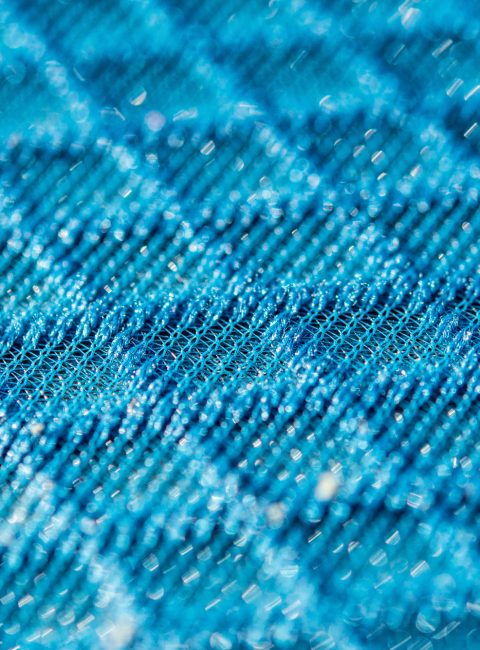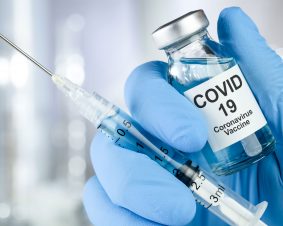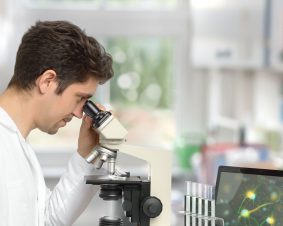 >
Spotlight February 2023: New sustainable and promising method to give cotton textiles an antiviral and antibacterial finish
>
Spotlight February 2023: New sustainable and promising method to give cotton textiles an antiviral and antibacterial finish
Textiles have been the subject of research into functionalization for many years, especially also to repel bacteria and viruses. Since the development of nanotechnological processes, there have been many attempts to incorporate UV protection with nano-titanium dioxide, or to provide textiles with anti-bacterial properties with nanosilver (see cross-sectional text “Nanoparticles in Textiles”). But nanosilver has come under discussion because the particles are washed out of the textile after a few washing processes and the function is thus weakened or lost, but also the resource silver is relatively rare and the environment is polluted with the washed-out silver.
There is a recent study that uses a completely different element to functionalize cotton fibres and make them permanently anti-viral and anti-bacterial: copper! The process of functionalization is very sustainable because the solutions/lyes can be reused and only the copper itself has to be added for a new run. However, the amount of copper is relatively small, and the tests of the study showed that the functionalization is maintained even after up to 1000 washings, whereas the textile made of cotton reached its end of life after only 200 washings.
The process of functionalization is simple and upscalable, the distribution of copper ions in the fabric is very uniform (no particulate deposition, but ionic bonds). Tests with various viruses and bacteria have shown that this tissue is very efficient in killing these pathogens. Even mechanical stresses, such as crumpling or folding, do not reduce the lasting effect. The blue coloration by the copper has the additional advantage that especially for clinical staff the clothes do not have to be dyed separately, which also contributes to the sustainability of the product. Copper is much cheaper than silver, which makes it possible to provide certain textiles with simple, cost-saving, effective and long-lasting anti-viral and anti-bacterial properties without harming the environment.
Original publication:
Qian, J.; Dong, Q.; Chun, K.; Zhu, D.; Zhang, X.; Mao, Y.; Culver, J.N.; Tai, S.; German, J.R.; Dean, D.P., et al. Highly stable, antiviral, antibacterial cotton textiles via molecular engineering. Nat Nanotechnol 2022.

Weitere Spotlights
Spotlight August 2023: From principles to reality. FAIR implementation in the nanosafety community
In the August 2023 Spotlight, we present a paper that addresses the implementation of FAIR (Findability, Accessibility, Interoperability and Reusability) Data in nanosafety research. The authors introduce the new AdvancedNano GO FAIR Implementation Network (see also https://www.go-fair.org/implementation-networks/overview/advancednano/) established as part of the GO FAIR initiative. The paper highlights the AdvancedNano GO FAIR Implementation Network’s support […]
Read moreSpotlight February 2021: Nanoobjects in the COVID-vaccine – scientifically correct?
The COVID-19 pandemic induces very different reactions of people on the internet (https://www.cdc.gov/mmwr/volumes/70/wr/mm7002e1.htm) and in the social networks. Without following the conspiracy theories as “5G nanochip hidden in COVID vaccines” some news as “COVID vaccines induce allergic reactions” should be scientifically recognised. The picture from the 5G-nanochip whose plan goes viral on the internet is […]
Read moreSpotlight January 2023: Special issue on Methods and Protocols in Nanotoxicology published
In the first Spotlight of the new year, we present a special issue on methods and protocols in nanotoxicology published in the journal Frontiers in Toxicology. There are still too few harmonized protocols accepted by the scientific community. To improve this situation, project activities are started and special issues of journals like this one are […]
Read moreSpotlight September 2021: Wood, the raw material of the future?
One of the greatest challenges facing humanity is to produce clean drinking water under the given circumstances of global warming, population growth and increasing littering. In September, we would like to present a review article that believes one approach to solve this problem is the use of nanoscale wood. In the review, “Advanced Nanowood Materials […]
Read more


